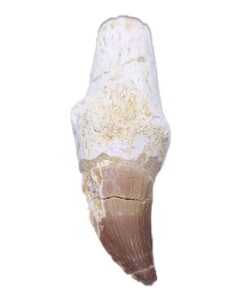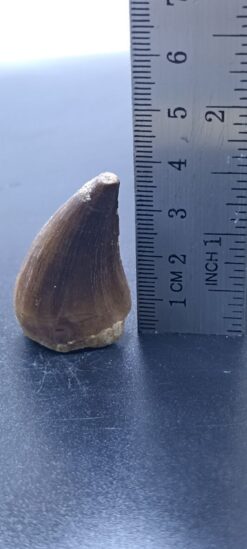Original Mosasaurus Prognathodon Currii Tooth Rooted 4.3″ Fossil
$ 210,00
1 in stock
|
Mosasaurus |
|
|
SPECIES |
Prognathodon Currii |
|
AGE |
Late Cretaceous (~70 Million Years) |
| LOCATION |
Sidi chennan basin, Morocco |
|
FORMATION |
Phosphate Deposits |
|
SIZE |
4.3″ long |
| CATEGORY |
Reptile, Amphibians & Synapsids |
| SUB CATEGORY |
Mosasaur Fossils |
This is a fossil Original tooth measuring 4.3 inches that belonged to Prognathodon currii, a large Mosasaur species from the Late Cretaceous period. The tooth was found in the phosphate deposits of the Sidi Chennane Basin located in Morocco. Prognathodon currii teeth are considered rare compared to other Prognathodon species, as they have a rounded or blunt tip instead of a pointed one.

The Sidi chennane Basin is a significant source of phosphate, which is one of Morocco’s primary exports. During the mining operations, fossils are collected as a byproduct, preventing them from being destroyed by the rock crusher.
Mosasaurs are a family of enormous marine reptiles that truly dominated the seas 90 million years ago. They ruled during the last 20-25 million years of the Cretaceous period. With the extinction of the ichthyosaurs and decline of plesiosaurs, mosasaurs diversified to become prolific apex predators in nearly every habitat of the oceanic world.
During the late Cretaceous period, mosasaurs were a dominant family of gigantic marine reptiles that ruled the seas approximately 90 million years ago. With the extinction of ichthyosaurs and a decline in the number of plesiosaurs, mosasaurs evolved to become prolific apex predators in nearly every oceanic habitat.
The larger mosasaurs were the great leviathans of their time, reaching lengths of 10-15 meters (33-49 feet). Hainosaurus, which holds the record for the longest mosasaur, was a massive 57 feet long. Even the smaller genera were still impressive, measuring 10-20 feet in length. Mosasaurs most likely evolved from semi-aquatic scaled reptiles that resembled modern-day monitor lizards. These marine reptiles had double-hinged jaws and flexible skulls, similar to those of snakes, allowing them to swallow their prey almost whole.
Through the analysis of fossilized mosasaur guts, scientists have discovered a varied diet consisting of sea birds, ammonites, smaller marine lizards, and possibly even sharks and other mosasaurs. Some mosasaurs had specialized teeth for crunching ammonites, which were abundant in the Cretaceous sea.
Mosasaurs were most likely ambush predators that lurked and darted out to swallow their unsuspecting prey, possibly using their powerful tail flukes for extra thrust. The non-reflective, keeled scales of mosasaurs may have given them an advantage in sneak-attacks.
Despite their ability to adapt and proliferate, mosasaurs were highly specialized, which may have contributed to their eventual demise when marine systems collapsed at the end of the Cretaceous period. Mosasaurs were air-breathing reptiles that gave birth to live young and were well-suited to living in the warm, shallow, epicontinental seas of their time.
Only logged in customers who have purchased this product may leave a review.
Related products
Prognathodon Anceps
1.5″ Great Mosasaur prognathodon anceps Tooth rare Fossil Reptile Morocco
Prognathodon Anceps
1.5″ great Mosasaur Prognathodon sp Rare fossil Morocco natural teeth

























Reviews
There are no reviews yet.